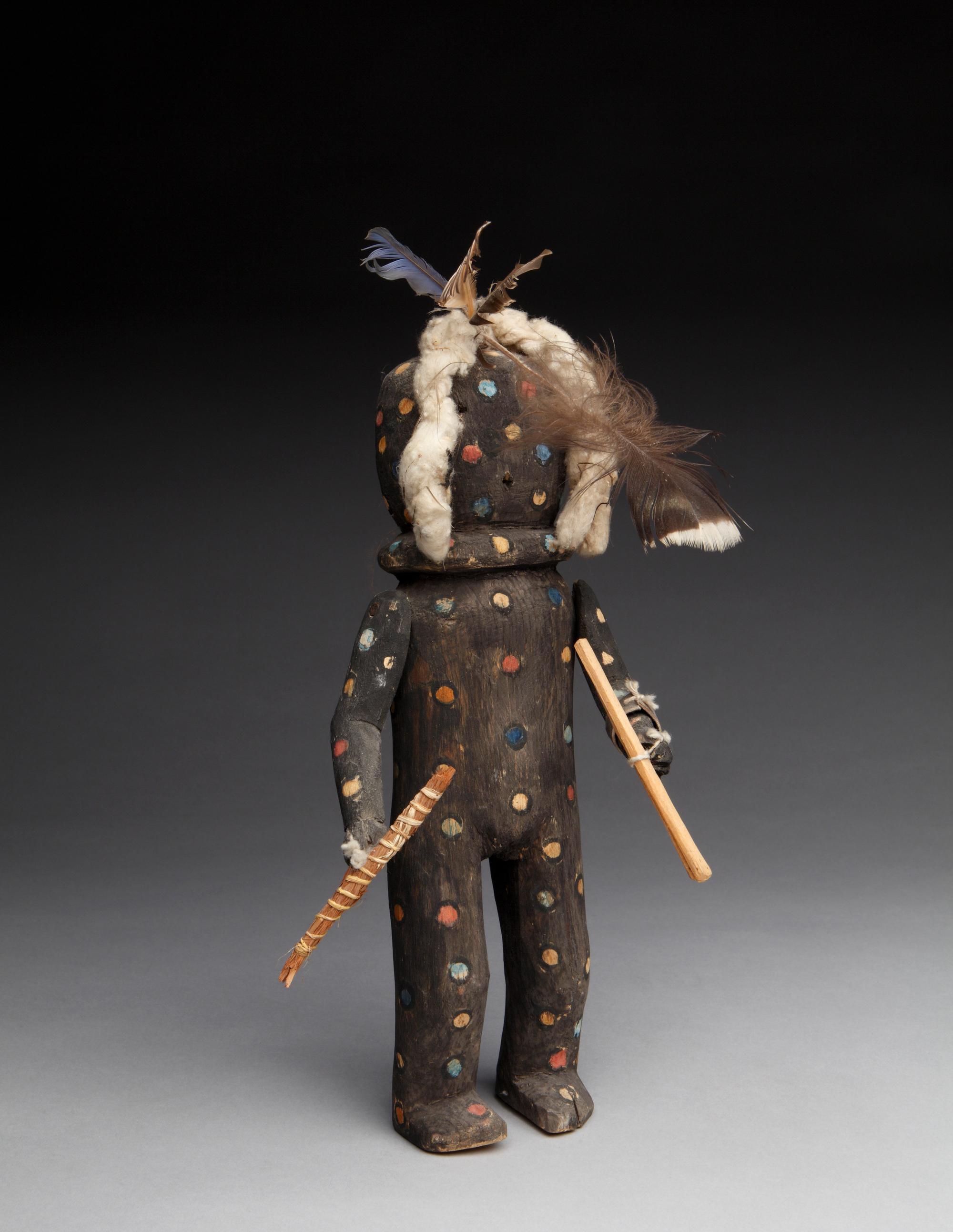
Photograph by Addison Doty. Copyright 2014 School for Advanced Research.
Shulawitsi Kwina kokko we'ha | Black Fire Keeper kokko figure
Date: before 1929
Artist or Maker: Unknown
Dimensions:
Overall: 26.7 cm (10 1/2 in.)
Medium: wood | paints | feathers | cotton
Credit Line: Gift of Mary V. Conkey.
Place Made:
Zuni Pueblo, McKinley County, New Mexico, Southwest, United States, North America
Object Number: IAF.C91
Not on view
Tribal Collection Review RemarksJim Enote and Octavius Seowtewa during collection review visit April 6 and 7, 2009 (Events Record “Collection Review: Zuni Tribe, Review 1”): "Kwina" means "black" in the Zuni language. This figure is similar to SAR.1978-1-117, Shulawitsi Kohana, who is also said to be a Fire Keeper. This black version of Shulawitsi (Shulawitsi Kwina) kokko comes out only during Shalako and is always represented by a young boy from the Badger Clan.
Shulawitsi Kwina dancers are painted with multi-colored "polka dots" over black body paint. Each of the colors represents one of the sacred directions. The colors are as follows: yellow represents north, blue is west, red is south, and white is east. Black represents below or bottom, while above or top is represented by multi colors, like stars twinkling at night because stars have different colors.
ADDITIONAL INFORMATION: Jim Enote and Octavius Seowtewa during collection review visit April 10 and 11, 2014 (Events Record “Collection Review: Zuni Tribe, Review 13”): The figure is carved from wood, though it’s not clear what kind. Some of the paints on it may be commercial poster paints (the black, dark blue, and red). The others may be natural pigment paints (the turquoise blue and yellow). The figure is missing white dots that the dancer would have. The cotton affixed to the figure’s head is hand-rolled natural cotton rope. This rope is meant to drape over the dancer’s face. The feathers attached to the cotton are turkey, duck, red-shafted flicker, and blue bird feathers, and they should point forward, over the figure’s face. The eyes and mouth are small drilled holes. (IARC staff moved the cotton rope and the feathers into the proper arrangement. It was later re-photographed to show it correctly attired.)
The arms are articulated at the shoulders and attached to the body with a nail through each shoulder. In its right hand, the figure holds a juniper bark bundle wrapped with yucca fiber. The bundle is fastened to the hand with white cotton string. In its left hand, it holds two pine sticks that represent a fire-starting kit. It’s fastened to the hand with white cotton string. There is a black leather bow guard on the left wrist, tied with white cotton string.
The figure is barefoot, which is correct for this dancer.
This figure is dressed for Shalako because of the items it carries in its hands. It also participates in the first summer solstice rain dance, called K’okwiaba in Zuni, or “Coming of the Kokko” in English, but it carries different items in its hands for that dance. See SAR.1994-8-122, which is carrying the items used in the K’okwiaba dance.
In Collection(s)
The Indian Arts Research Center, in collaboration with Native American community scholars, strives to present accurate collections records. Records may be updated as new information becomes available and is reviewed with the Native American community having cultural affinity to particular items. Please write to iarc@sarsf.org if you have questions or concerns related to the documentation.
